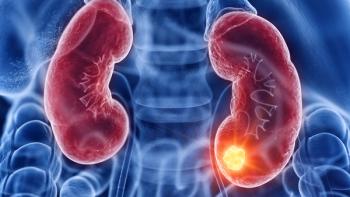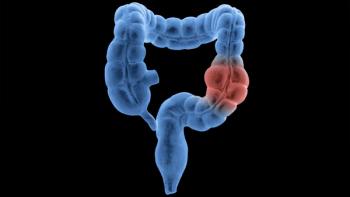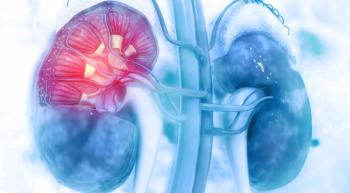
Regional Nodal Irradiation Is Not Associated With Significantly Reduced Locoregional Recurrence Rates in Favorable-Risk, Node-Positive Breast Cancer
At a follow-up of 6.1 years, patients who received regional nodal irradiation did not achieve significant reductions in locoregional recurrence rates compared to those who received surgery alone.
The addition of regional nodal irradiation (RNI) to a patient’s treatment regimens did not lead to a significant reduction in locoregional recurrence rates (LRRs) among patients with favorable-risk, node-positive hormone receptor-positive, HER2-negative breast cancer, according to findings from the phase 3 SWOG S1007 RxPONDER trial (NCT01272037) published in JAMA Oncology.1
At a median follow-up of 6.1 years, findings from the secondary analysis showed that patients who received breast-conserving surgery and radiotherapy with RNI (n = 1522), breast-conserving surgery with radiotherapy (n = 1397), mastectomy with postmastectomy radiotherapy (n = 901), and mastectomy without radiotherapy (n = 760) experienced 5-year LRRs of 0.85%, 0.55%, 0.11%, and 1.7%, respectively. Additionally, the invasive disease-free survival (iDFS) rate was not affected by the presence or lack of RNI among patients who were premenopausal (HR, 1.03; 95% CI, 0.74-1.43; P = .87) or postmenopausal (HR, 0.85; 95% CI, 0.68-1.07; P = .16).1
Additional findings from the analysis showed that predictors of RNI receipt following breast conserving surgery included having a tumor size of T3 vs T1 (OR, 2.80; 95% CI, 1.70-4.63; P < .001), having 2 positive nodes vs 1 (OR, 1.67; 95% CI, 1.40-2.00; P < .001), and having 3 positive nodes vs 1 (OR, 2.76; 95% CI, 2.00-3.79; P < .001). Similarly, predictors of receipt of radiotherapy after mastectomy included having a tumor size of T3 vs T1 (OR, 9.02; 95% CI, 5.58-14.57; P < .001), having 2 positive nodes vs 1 (OR, 1.60; 95% CI, 1.27-2.01; P < .001), and having 3 positive nodes vs 1 (OR, 3.18; 95% CI, 2.25-4.51; P < .001).1
Patients who were premenopausal had a lower incidence of locoregional recurrence when they received breast-conserving surgery plus radiotherapy compared with mastectomy alone (HR, 0.41; 95% CI, 0.19-0.91; P = .03); this trend was also true among postmenopausal women (HR, 0.48; 95% CI, 0.20-1.13; P = .09).
iDFS among premenopausal women was significantly improved for patients who received breast conserving surgery plus radiotherapy without RNI vs mastectomy (HR, 0.60; 95% CI, 0.37-0.95; P = .03). None of the other treatment combinations compared with mastectomy without radiotherapy provided a significant benefit in terms of iDFS in either premenopausal or postmenopausal women.
Primary results from the trial, which were published in the New England Journal of Medicine in 2021, showed that adding chemotherapy to endocrine therapy did not provide a large iDFS benefit in the overall population; the 5-year iDFS rates were 92.2% vs 91.0% among patients in the chemoendocrine (n = 2487) and endocrine only (n = 2497) arms, respectively (HR, 0.86; 95% CI, 0.72-1.03; P = .10). However, premenopausal patients did experience a significant benefit in terms of iDFS with chemoendocrine therapy compared with endocrine therapy alone (HR, 0.60; 95% CI, 0.43-0.83; P = .002).2
To conduct the secondary analysis of S1007 published in JAMA Oncology, investigators used a prospective radiotherapy data collection form to collect data on radiotherapy receipt, targets, and dose for patients enrolled on the trial.1 RNI was defined based on an indication of treatment targets at least including the supraclavicular area. Investigators also described radiotherapy receipt to the internal mammary in addition to performing a sensitivity analysis that considered an alternative definition of RNI which included targeting of nodal regions.1
Multivariable logistic regression models were subsequently constructed using the following independent variables: menopausal status (premenopausal vs postmenopausal), sentinel lymph node biopsy vs axillary dissection, tumor size (T1, T2, or T3), number of positive lymph nodes (1, 2, or 3), and recurrence score. Radiotherapy information was recorded in the first year after random assignment. Findings were analyzed from June 2022 to April 2023.1
In SWOG S1007 RxPONDER eligible patients needed to have noninflammatory disease without distant metastasis, received primary surgery with sentinel-node biopsy or axillary lymph-node dissection, and be able to undergo a taxane and/or anthracycline-containing regimen.2
Patients were randomly assigned 1:1 to be treated with either chemoendocrine therapy or chemotherapy alone. The primary end point was iDFS, secondary end points included distant relapse-free survival and overall survival.2
The analysis collected data from a total of 4871 female patients with a median age of 57 years (range, 18-87). Patients in the breast-conserving surgery and radiotherapy with RNI, breast-conserving surgery with radiotherapy, mastectomy plus radiotherapy, and mastectomy alone arms underwent endocrine monotherapy at rates of 49.9%, 52.3%, 49.1%, and 53.0%, respectively. Most patients in each arm were postmenopausal (69.9% vs 70.0% vs 58.1% vs 65.6%), had 1 positive node (60.5% vs 76.3% vs 53.4% vs 69.2%), and had a recurrence score of 14 to 25 (57.5% vs 57.1% vs 55.6% vs 58.2%).1
Study authors concluded by noting that these findings emphasize the need to evaluate when RNI should be omitted for this patient population “… these findings provide valuable information by suggesting that further investigation of RNI omission in this population is worthwhile and that omission of chemotherapy among patients similar to those enrolled on S1007 is not itself an independent indication for use of RNI. These findings reinforce the need for prospective trials investigating optimal locoregional management and radiotherapy field design in patients with limited nodal burden and favorable biology,” they wrote in conclusion.1
References
- Jagsi R, Barlow WE, Woodward WA, et al. Radiotherapy use and incidence of locoregional recurrence in patients with favorable-risk, node-positive breast cancer enrolled in the SWOG S1007 trial. JAMA Oncol. Published online July 6, 2023. doi:10.1001/jamaoncol.2023.1984
- Kalinsky K, Barlow WE, Gralow JR, et al. 21-gene assay to inform chemotherapy benefit in node-positive breast cancer. N Engl J Med. 2021;385(25):2336-2347. doi:10.1056/NEJMoa2108873
Newsletter
Knowledge is power. Don’t miss the most recent breakthroughs in cancer care.

























































































